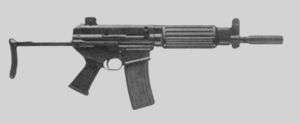Daewoo Precision Industries K1
| Daewoo Precision Industries K1A | |
|---|---|
|
The Daewoo Precision Industries K1A | |
| Type | Submachine gun |
| Place of origin | Republic of Korea |
| Service history | |
| In service | 1981-present |
| Used by | See Users |
| Wars |
Persian Gulf War War in Afghanistan[1] Iraq War[1] |
| Production history | |
| Designer |
Agency for Defense Development Daewoo Precision Industries |
| Designed | 1977-1982 |
| Manufacturer |
Daewoo Precision Industries S&T Daewoo S&T Motiv |
| Produced | 1980-present |
| Variants | See Variants |
| Specifications | |
| Weight | 2.87 kg (6.3 lb) |
| Length |
838 mm (33.0 in) (stock extended) 653 mm (25.7 in) (stock retracted) |
| Barrel length | 263 mm (10.4in) |
|
| |
| Cartridge | .223 Remington |
| Action | Gas-operated, rotating bolt (direct impingement) |
| Rate of fire | 700-900 rounds/min |
| Muzzle velocity | 820 m/s (2,700 ft/s) |
| Effective firing range | 250 m |
| Feed system | Various STANAG magazines. |
| Sights | Iron sights |
The Daewoo Precision Industries K1/K1A is a South Korean submachine gun,[2] the first modern firearm developed by Agency for Defense Development (ADD) and manufactured by Daewoo Precision Industries,[3] and entered service in the Republic of Korea Armed Forces in 1981. Although the K1 uses .223 Remington, it is classified as a submachine gun by the South Korean military and the current manufacturer S&T Motiv, because the K1 was intended to replace the M3 submachine gun. Outside of South Korea the K1 is sometimes described as an assault rifle or as a carbine.
Development

In 1976, the ROKA Special Warfare Command requested a new weapon to replace the old M3 submachine gun. In the following year, ADD launched a project derived from XB rifle, which started in 1972 to replace licensed M16A1s with indigenous weapons. Under the demands of the ROKASWC, the new submachine gun must acquire greater firepower, light weight, cost effectiveness, and easy access to spare parts. The first prototypes were made in 1980, and entered service in 1981 after series of field test. However, due to the design of its flash suppressor, the K1 exhibited serious problems in service with the ROK armed forces. The original version had excessive recoil, noise, flash, and weak stock due to increase in firepower. These problems caused difficulty in aiming especially during night operation.
These shortcomings were later fixed by the development and adoption of a new flash suppressor, which has three holes in the top right quadrant to limit muzzle flip under rapid fire and reduces flash to one-third of that of the early K1. This new version of K1 is known as the K1A and its production began in 1982. All K1 sumbmachine gun in service were subsequently modified to the K1A standard.
The K1A is often mated with the PVS-4K Rail integration System.
Differences
Most of the time, K1 submachine gun is regarded as a shortened or carbine version of Daewoo Precision Industries K2 assault rifle. However, although two guns share development history, two guns are very different from each other for the following reasons:
- The development of K1 was completed earlier than that of K2.[4]
- The K1 uses the direct impingement gas system, while the K2 uses AK-47 style gas piston system.[4]
- The K1 has 1-in-12 rifling twist for .223 Remington, while the K2 has 1-in-7.3 rifling twist for 5.56×45mm NATO (FN SS109).[4]
The carbine version of K2 named K2C was developed and shown to the public in 2012 by S&T Motiv.
Variants
- XK1: Experimental prototype.
- K1: First mass-produced variant. Every K1 has been modified to K1A standard.
- K1A: Second mass-produced enhanced variant.
- MAX-1: Semi-automatic version of K1A for civilian market.[5]
- K1A1: Civilian version of K1A with longer barrel.
Users
 Bangladesh[6]
Bangladesh[6] Republic of Korea: Standard-issued submachine gun of the ROK Armed Forces.[1] K2C carbine is under field test to possibly replace K1A.[7]
Republic of Korea: Standard-issued submachine gun of the ROK Armed Forces.[1] K2C carbine is under field test to possibly replace K1A.[7] Papua New Guinea[8]
Papua New Guinea[8] Senegal: Received 280 K1A rifles in 2003.[9]
Senegal: Received 280 K1A rifles in 2003.[9]
Future replacement
S&T Motiv K2C, upgraded and carbine version of K2 rifle, is under test by the Republic of Korea Army Special Warfare Command for the replacement. The Republic of Korea Armed Forces is planning to field K2C starting in 2015.
See also
- Daewoo Precision Industries K2: related development
- S&T Motiv K2C: potential replacement currently undergoing field test
- Daewoo Precision Industries K7: 9×19 Parabellum submachine gun with permanent silencer based on K1A
- S&T Daewoo XK9: suggested 9×19 Parabellum submachine gun prototype to replace K1A used by special forces
References
- 1 2 3 "Archived copy" (PDF). Archived from the original (PDF) on 2011-07-07. Retrieved 2010-06-18.
- ↑ "E-Catalog" (PDF).
- ↑ "Business Outline, Defense Business". S&T Daewoo. Retrieved 2010-07-01.
- 1 2 3 "Daewoo K1". Rifles n Guns. Retrieved 2008-10-30.
- ↑ "Daewoo K2 assault rifle and K1 assault carbine". Retrieved 2008-10-30.
- ↑ http://www.bdmilitary.com/index.php?option=com_content&view=article&id=71&Itemid=95
- ↑ "보병 기본화기 31년 만에 개량 교체.. 육군 내년부터 K2 개량형 순차 보급".
- ↑ http://news.mk.co.kr/newsRead.php?year=2014&no=1454840
- ↑ http://article.joinsmsn.com/news/article/article.asp?ctg=12&Total_ID=195149
External links
| Wikimedia Commons has media related to Daewoo K1. |
